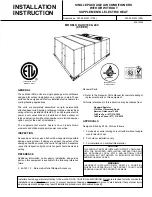
TESTING
PAGE 27
ENGLISH
4 way valve testing
The 4 way valve will control the direction of hot gas discharge via an
internal slide assembly. The valve has a line voltage solenoid that is en
-
ergized when heat mode operation is desired. The solenoid will direct
the internal slide to send the hot gas to the indoor coil. During cooling
mode de-energized operation, the internal slide will direct compres
-
sor hot gas to the outdoor coil.
4 way valves may have a failure of the electrical solenoid that pre
-
vents the valve from shifting, or they may become stuck due to debris
lodging inside the valve body. If the valve fails to direct the hot gas in
the proper direction, temperature sensors within the outdoor unit will
detect the problem and generate an Error Code.
If the valve fails to shift the hot gas to the proper coil, or it only partially shifts, perform the following test:
1.
Make sure the system has proper charge.
2.
Place the system in heat mode and call for heat. After a time delay, the valve solenoid should be energized by the ECU.
Check for line voltage to the solenoid.
3.
If the valve has voltage but fails to shift the hot gas to the indoor coil, shut the system down and unplug the 4 way valve
from the ECU electrical plug.
4.
Use an Ohmmeter to check for continuity through the solenoid coil. Check If the coil checks out good, but the valve will
not shift, the 4 way valve is bad. Replace the valve.
5.
If the coil checks out bad, replace the coil.
6.
Note partial shifting of the valve can be detected by
measuring the temperature of the suction gas where it enters the reversing valve and then comparing that temperature
to the temperature of the suction gas exiting the 4 way valve. There should be no more than 13°F difference between entering
suction gas temperature and leaving suction gas temperature. Excessive temperature rise through the suction gas path is an
indication of a partial sliding valve. The temperature rise detected is due to hot gas bleeding through the slide assembly into the
suction side of the system. Replace the 4 way valve.
Outdoor Fan Motor Testing
If the outdoor unit fan motor does not run or the Service Monitor board indicates an error code of
09, check the following voltages at connector CN11 on the outdoor unit ECU board. Set the meter
to read DC volts with a minimum voltage range of 350 volts. All voltage values are approximate.
Initiate forced cooling.
(Press and hold the power button for 10 seconds on the wired controller.)
1)
DC voltage between the Red and Black wires on the CN11 plug should read
310 ~ 334VDC. (This is the main voltage for powering the fan motor)
2)
DC voltage between the White and Black wires on the CN11 plug should read
15VDC. (This is the voltage for powering the electronic circuit of the fan motor)
3)
DC voltage between the Yellow and Black wires on the CN11 plug should read
4VDC. The voltage will read 0VDC when the fan is not being called to operate. (This is the
control voltage for regulating the speed of the fan motor)
4)
DC voltage between the Blue and Black wires on the CN11 plug should read
8VDC. The voltage will read 14VDC when the fan is not being called to operate.
(This is the feedback voltage to the ECU board for determining the speed of the
fan motor)
If the outdoor fan initially runs, increases speed and then stops, and the Service Monitor board in
-
dicates an error code of 09, the feedback circuit is not functioning. Check that the wiring and plug
connections are secure.
OUTDOOR UNIT TESTING PROCEDURES
Outdoor Fan 310VDC
Pins 1 - 3
Outdoor Fan 15VDC
Pins 3 - 4
Outdoor Fan Control
Pins 3 - 5
Outdoor Fan Feedback
Pins 3 - 6
1
2
3
4
Содержание AW07LC2VHA
Страница 3: ...PAGE 3 ENGLISH INTRODUCTION SPECIFICATIONS Multi Zone Indoor...
Страница 4: ...PAGE 4 ENGLISH INTRODUCTION SPECIFICATIONS Multi Zone Indoor...
Страница 5: ...PAGE 5 ENGLISH INTRODUCTION SPECIFICATIONS Multi Zone Outdoor...
Страница 72: ...REFERENCES PAGE 72 ENGLISH Problem Problems Solutions Length Limits Piping Length Limits REFERENCES...
Страница 73: ...REFERENCES PAGE 73 ENGLISH Component Ratings REFERENCES...
Страница 76: ...REFERENCES PAGE 76 ENGLISH Wiring REFERENCES...
Страница 77: ...REFERENCES PAGE 77 ENGLISH Wiring REFERENCES...
Страница 78: ...REFERENCES PAGE 78 ENGLISH Wiring REFERENCES...
Страница 79: ...REFERENCES PAGE 79 ENGLISH Wiring REFERENCES...
Страница 80: ...REFERENCES PAGE 80 ENGLISH Wiring REFERENCES...
Страница 81: ...REFERENCES PAGE 81 ENGLISH 2U Wiring REFERENCES...
Страница 82: ...REFERENCES PAGE 82 ENGLISH CN20 Connector for room card Wiring REFERENCES...
Страница 83: ...REFERENCES PAGE 83 ENGLISH SWI Wiring REFERENCES...
Страница 84: ...REFERENCES PAGE 84 ENGLISH Wiring REFERENCES...
Страница 86: ...REFERENCES PAGE 86 ENGLISH CIRCUIT DIAGRAMS REFERENCES...
Страница 87: ...REFERENCES PAGE 87 ENGLISH CIRCUIT DIAGRAMS REFERENCES...
Страница 88: ...REFERENCES PAGE 88 ENGLISH WIRING DIAGRAMS REFERENCES...
Страница 89: ...REFERENCES PAGE 89 ENGLISH WIRING DIAGRAMS REFERENCES...
Страница 90: ...REFERENCES PAGE 90 ENGLISH 2U Piping Installation Dimensions REFERENCES...
Страница 92: ...REFERENCES PAGE 92 ENGLISH Refrigerant Diagram REFERENCES...
Страница 93: ...REFERENCES PAGE 93 ENGLISH Refrigerant Diagram REFERENCES...
Страница 94: ...REFERENCES PAGE 94 ENGLISH 3U Piping Installation Dimensions REFERENCES...
Страница 95: ...REFERENCES PAGE 95 ENGLISH 4U Piping Installation Dimensions REFERENCES...
Страница 110: ...REFERENCES PAGE 110 ENGLISH SENSORS Value of Thermistor Indoor Unit...
Страница 111: ...REFERENCES PAGE 111 ENGLISH SENSORS...
Страница 112: ...REFERENCES PAGE 112 ENGLISH SENSORS...
Страница 113: ...REFERENCES PAGE 113 ENGLISH SENSORS...
Страница 114: ...REFERENCES PAGE 114 ENGLISH SENSORS...
Страница 115: ...REFERENCES PAGE 115 ENGLISH SENSORS...
Страница 116: ...REFERENCES PAGE 116 ENGLISH SENSORS...
Страница 117: ...REFERENCES PAGE 117 ENGLISH SENSORS...
Страница 118: ...REFERENCES PAGE 118 ENGLISH SENSORS...
Страница 119: ...REFERENCES PAGE 119 ENGLISH SENSORS...
Страница 120: ...REFERENCES PAGE 120 ENGLISH SENSORS...
Страница 121: ...REFERENCES PAGE 121 ENGLISH SENSORS...
















































